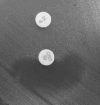Role of class A penicillin-binding proteins in the expression of beta-lactam resistance in Enterococcus faecium
- PMID: 19304851
- PMCID: PMC2681891
- DOI: 10.1128/JB.01834-08
Role of class A penicillin-binding proteins in the expression of beta-lactam resistance in Enterococcus faecium
Abstract
Peptidoglycan is polymerized by monofunctional d,d-transpeptidases belonging to class B penicillin-binding proteins (PBPs) and monofunctional glycosyltransferases and by bifunctional enzymes that combine both activities (class A PBPs). Three genes encoding putative class A PBPs (pbpF, pbpZ, and ponA) were deleted from the chromosome of Enterococcus faecium D344R in all possible combinations in order to identify the glycosyltransferases that cooperate with low-affinity class B Pbp5 for synthesis of peptidoglycan in the presence of beta-lactam antibiotics. The viability of the triple mutant indicated that glycan strands can be polymerized independently from class A PBPs by an unknown glycosyltranferase. The susceptibility of the DeltapbpF DeltaponA mutant and triple mutants to extended spectrum cephalosporins (ceftriaxone and cefepime) identified either PbpF or PonA as essential partners of Pbp5 for peptidoglycan polymerization in the presence of the drugs. Mass spectrometry analysis of peptidoglycan structure showed that loss of PonA and PbpF activity led to a minor decrease in the extent of peptidoglycan cross-linking by the remaining PBPs without any detectable compensatory increase in the participation of the L,D-transpeptidase in peptidoglycan synthesis. Optical density measurements and electron microscopy analyses showed that the DeltapbpF DeltaponA mutant underwent increased stationary-phase autolysis compared to the parental strain. Unexpectedly, deletion of the class A pbp genes revealed dissociation between the expression of resistance to cephalosporins and penicillins, although the production of Pbp5 was required for resistance to both classes of drugs. Thus, susceptibility of Pbp5-mediated peptidoglycan cross-linking to different beta-lactam antibiotics differed as a function of its partner glycosyltransferase.
Figures






References
-
- Clinical and Laboratory Standards Institute. 2007. Methods for dilutions antimicrobial susceptibility tests for bacteria that grow aerobically, 7th ed. Approved standard M7-A7. Clinical and Laboratory Standards Institute, Wayne, PA.
-
- Dunny, G., C. Funk, and J. Adsit. 1981. Direct stimulation of the transfer of antibiotic resistance by sex pheromones in Streptococcus faecalis. Plasmid 6270-278. - PubMed
Publication types
MeSH terms
Substances
Grants and funding
LinkOut - more resources
Full Text Sources
Research Materials
Miscellaneous

